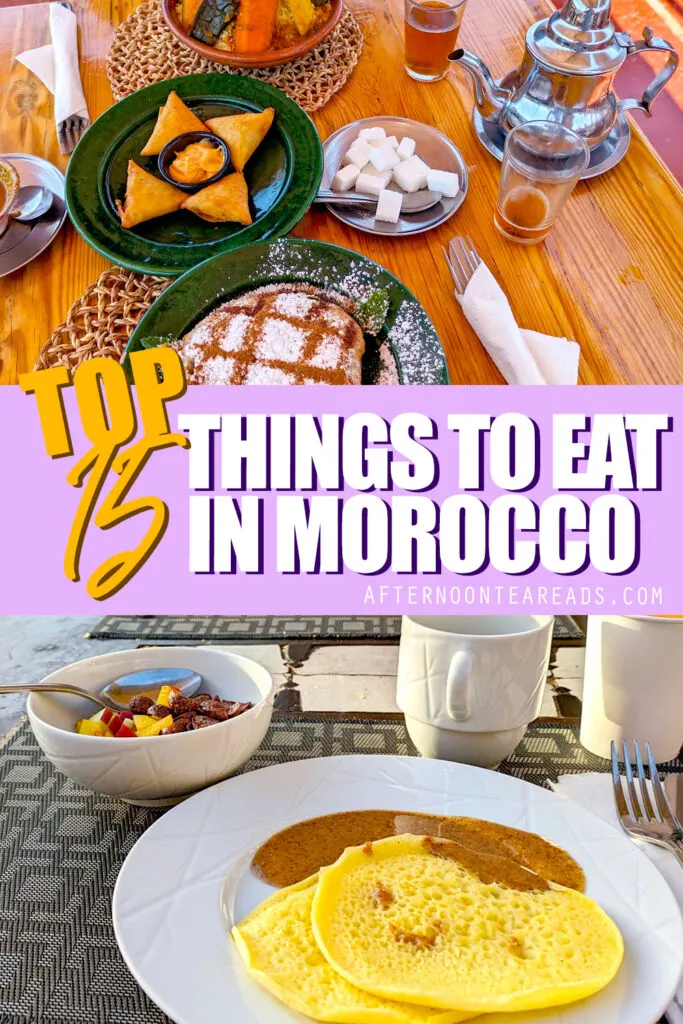These were my top 15 Moroccan foods that blew me away my first time in Morocco! Plus I even included some of my top Moroccan desserts to try!
Psst! This blog post contains affiliate links in it which sends me a bit of extra money if you use them… at no extra cost to you!
Top 15 Moroccan Foods You Need To Try
A lot of popular foods in Morocco are actually a general category rather than a specific dish (like tajine and couscous). So you can have many different varieties of classic Moroccan dishes.
What this means for you, is that just because you try a dish once, doesn’t mean you shouldn’t try it again. In facts, it’s the opposite.
You want to try Moroccan foods as many times as you can, because no two will be the same (well unless they’re from the same restaurant!).
P.S. I did two cooking classes, like this one in Marrakech, while in Morocco and highly recommend it if you’re interested in learning more about classic Moroccan dishes and the secrets to all the best flavours.

1. Tajine
Let’s start with one of the most obvious classic Moroccan dishes: tajine.
Tajine is the best example of a category for Moroccan foods. Tajine isn’t one dish, but rather just describes the cooking vessel.
A tajine is a terracotta pot with a cone shaped lid. It’s as if you said cast iron to describe a dish… So you can cooked anything you want inside a tajine.
Tagine dishes are often slow cooked chickens or stews, with some of the most soft and tender meats.
But there are three popular types of tajines I recommend seeking out: honey chicken, chicken with preserved lemon, and Berber tajine.
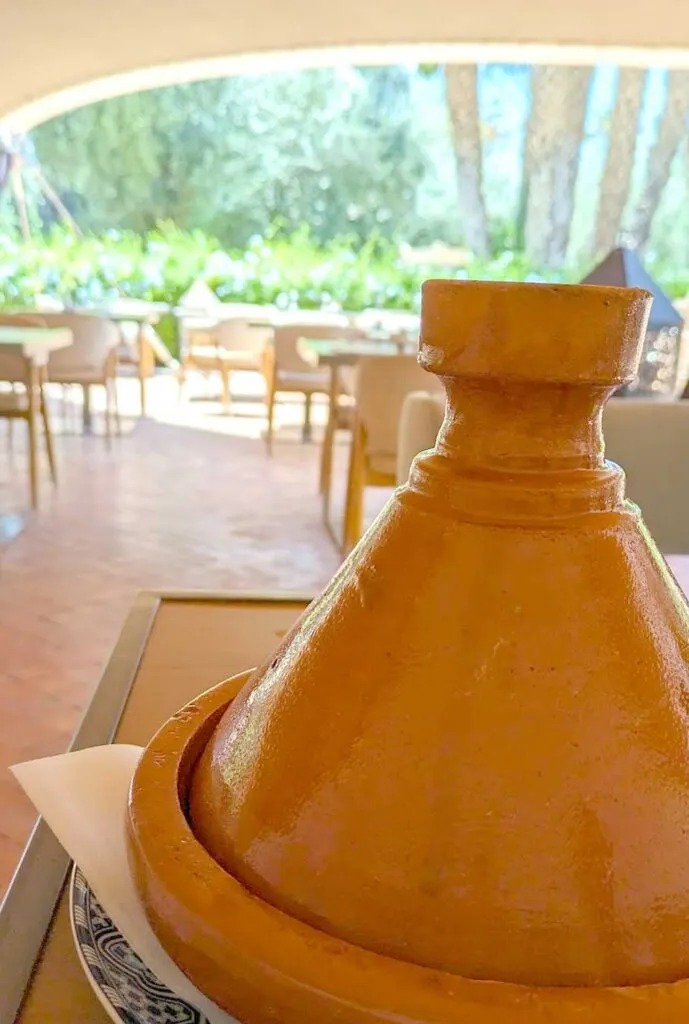
Honey chicken is a delicious blend of savoury and sweet as it uses honey but also classic Moroccan spices like cinnamon!
Chicken with preserved lemon is another unique dish. Preserved lemon is a staple in Moroccan households, and it’s exactly what it sounds like. It’s a lemon that’s been preserved (with A LOT of salt by the way!).
Chicken with preserved lemon is cooked with this lemon, adding a beautiful brightness and acidity to the dish.
Berber tagine is another popular dish in Morocco. It’s often served with either lamb or chicken with vegetables on top.
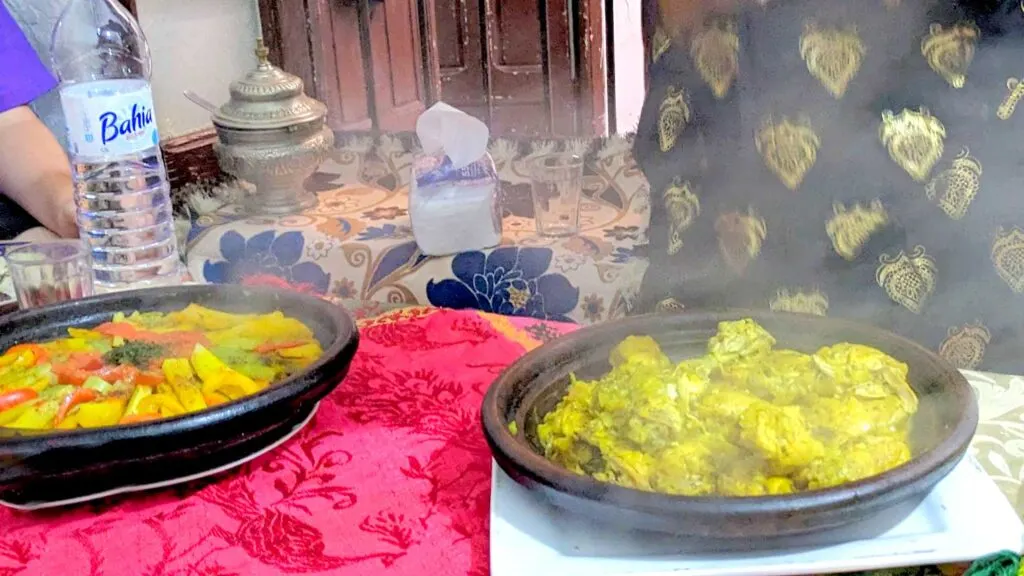
2. Couscous – Traditional Moroccan Food
Although you might think you are simply getting the grain, couscous describes a full meal in Morocco.
When you order couscous, it actually comes with vegetables and meat (often chicken or lamb).
The proper way to serve couscous is with the couscous on the bottom, the meat in the middle covered by all the vegetables in a tower on top.
The broth that was used to cook the vegetables and meat is then poured on the couscous for added flavours.
Fun fact: Although it’s often categorized as a grain, couscous is actually a pasta. It’s a rolled semolina flour with water.

3. Mint Tea (Nana)
Even if you’ve had Moroccan mint tea before, it’s ten times better in Morocco!
Moroccan mint tea is actually a green tea blend. It’s Moroccan mint paired with gunpowder green tea (a green tea from China). It’s then served with more fresh Moroccan mint tea leaves in your glass and sugar can be added to taste.
Traditionally, adding sugar was a statement over adding sweetness. Sugar was a sign of wealth, so the more sugar you added, the wealthier you were.
But today you can add as much, or as little as you want for taste!
P.S. You might be interested in: Marrakech travel planner with a Moroccan food checklist!

Moroccan mint tea is often served as a welcome drink to guests, so it’s popular to serve when you arrive at your hotel for check-in!
Otherwise you can still order it at cafes or restaurants throughout Morocco.
The most authentic way to enjoy mint tea is to pour it out from the teapot from as high as possible!
Where to try it in Marrakech: My favourite Moroccan mint tea was actually at Cafe Majorelle (inside the Jardins Majorelle) because our waiter poured it for us and it was the highest I’d seen in Morocco!
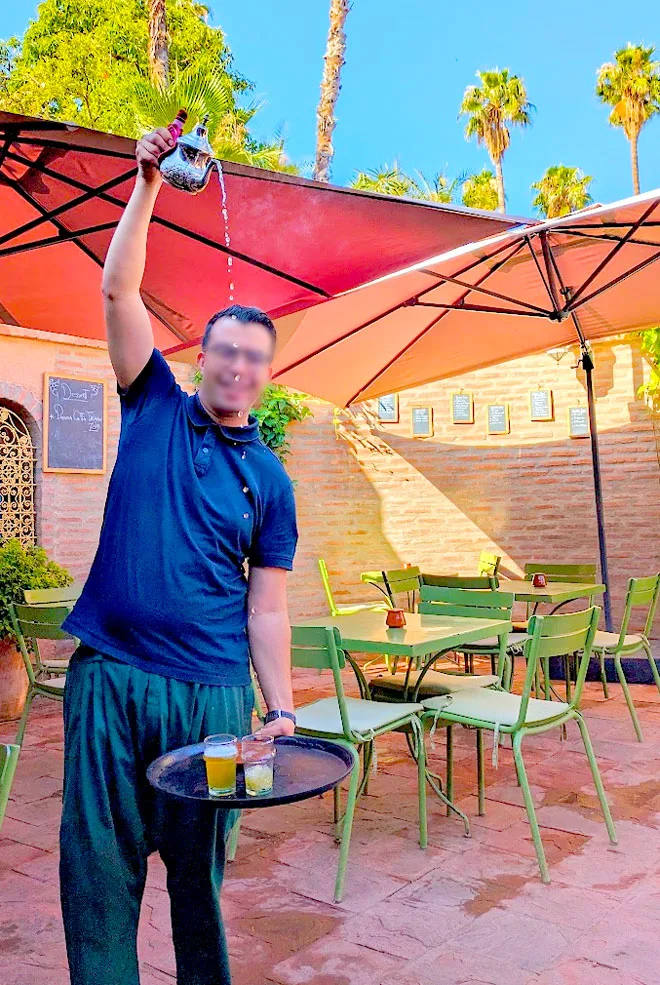
4. Argan Oil
There are two types of argan oil – cosmetic and culinary. You’re interested in culinary argan oil (although Morocco will try to sell you on the benefits of cosmetic argan oil ad nauseam!)!
Culinary argan oil is like olive oil but instead of coming from pressing olives, it’s from grinding the kernels of the fruit of the argan tree. It also has a nutty taste rather than an olive taste!
But similar to olive oil, it’s rich enough in flavours that it can be enjoyed on its’ own, either as a dressing on salad (or couscous), or as a dip for bread.
It can also be used as an ingredient in cooking, and is used in other traditional Moroccan food!

5. Amlou – Best Food In Morocco!
Simply put, Amlou is an almond spread.
It’s often described as Morocco’s Nutella, but feels more like a natural, sweetened, almond butter.
Amlou is a spread that’s a mix of almonds, argan oil, and honey. It’s served as a spread with jams and honey for breakfast.
Whatever you want to call it, it’s delicious.
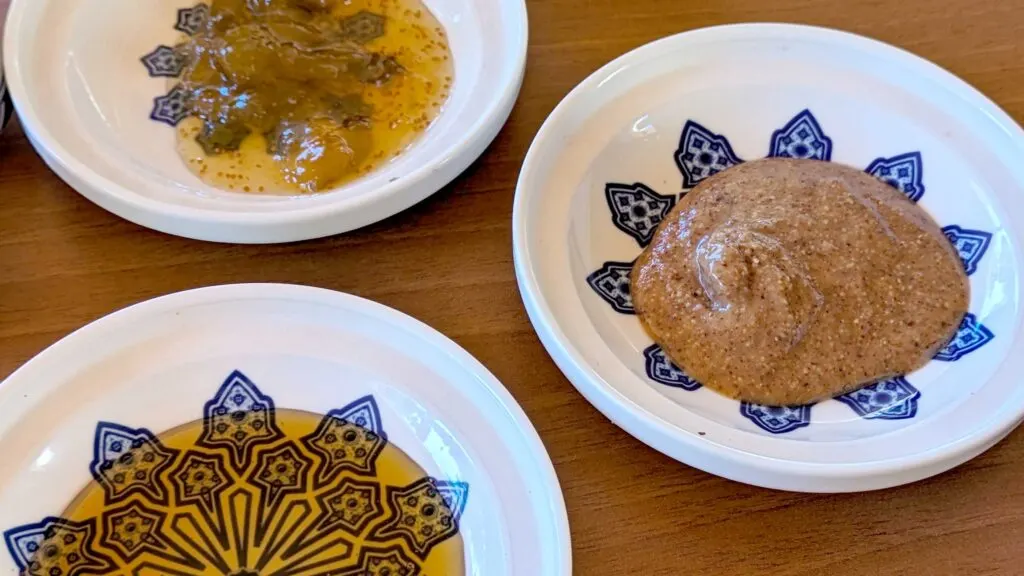
6. Moroccan Honey
Now I know you’ve probably had honey before, but have you had Moroccan honey?
Honey always tastes different based on where it’s from because the flowers the bees pollinate differ based on location.
So your hometown honey will most likely taste different than Moroccan honey (unless you have the same flowers!).
On top of that, Moroccan honey can come in many unique flavours, like orange blossom and cinnamon honey.
Try Moroccan honey at breakfast with different Moroccan breads (more on those in a bit!).
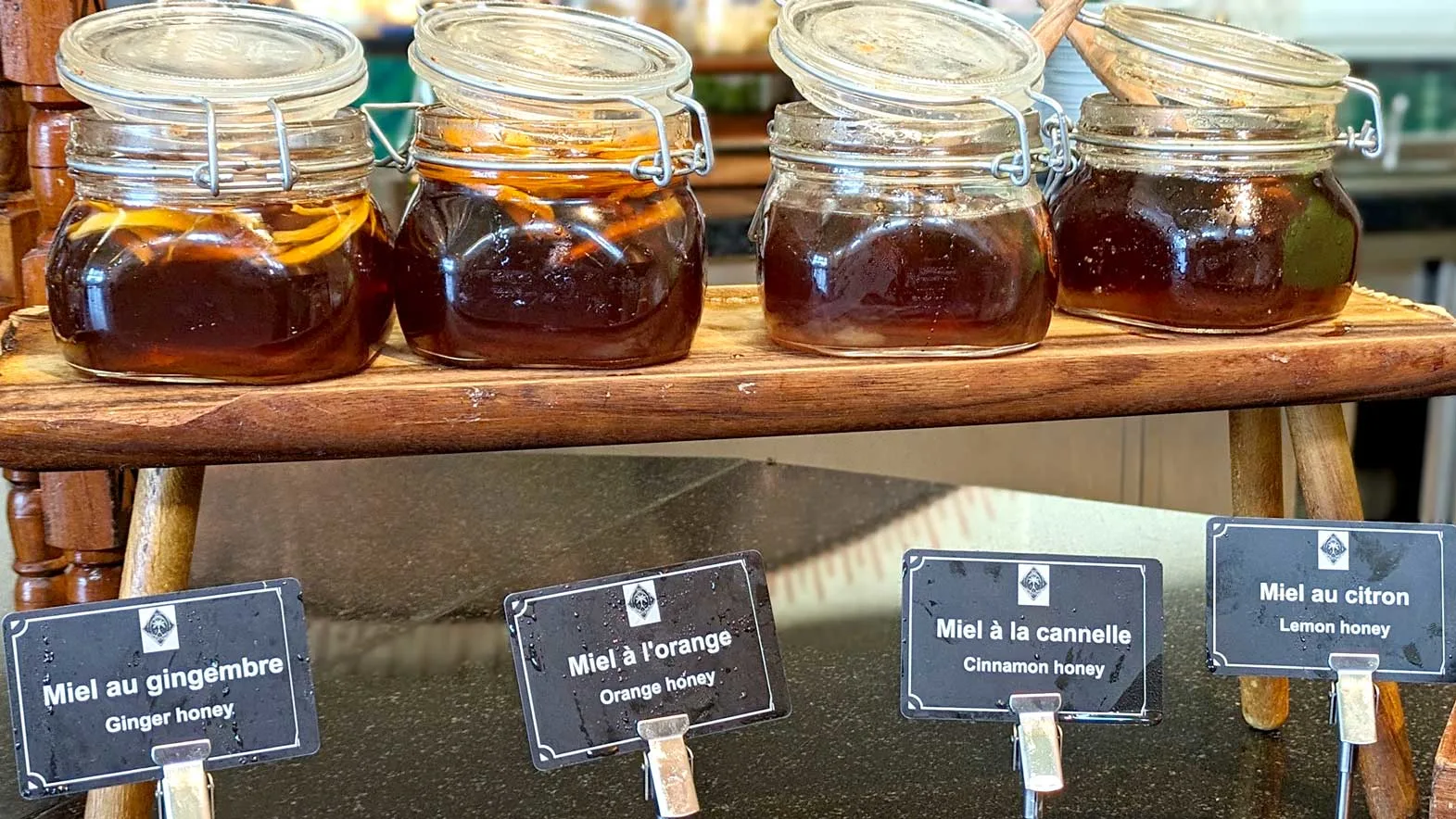
7. Merguez
I always thought merguez was from Italy, like Italian sausage. But, it’s actually from North Africa. So it should have been no surprise that it’s very popular in Morocco.
Merguez is a thin, spiced sausage, typically made with lamb, beef, or both. It’s a deep red colour because of the harissa spices mixed with the meat.
For someone who doesn’t eat pork, this was a breath of fresh air! I’m never able to eat any sausages when I travel! P.S. read my tips on travelling as a picky eater!
Where to try it in Marrakech: Terrasse Bakchich has a rooftop patio and serves traditional Moroccan food, including Merguez tajine!
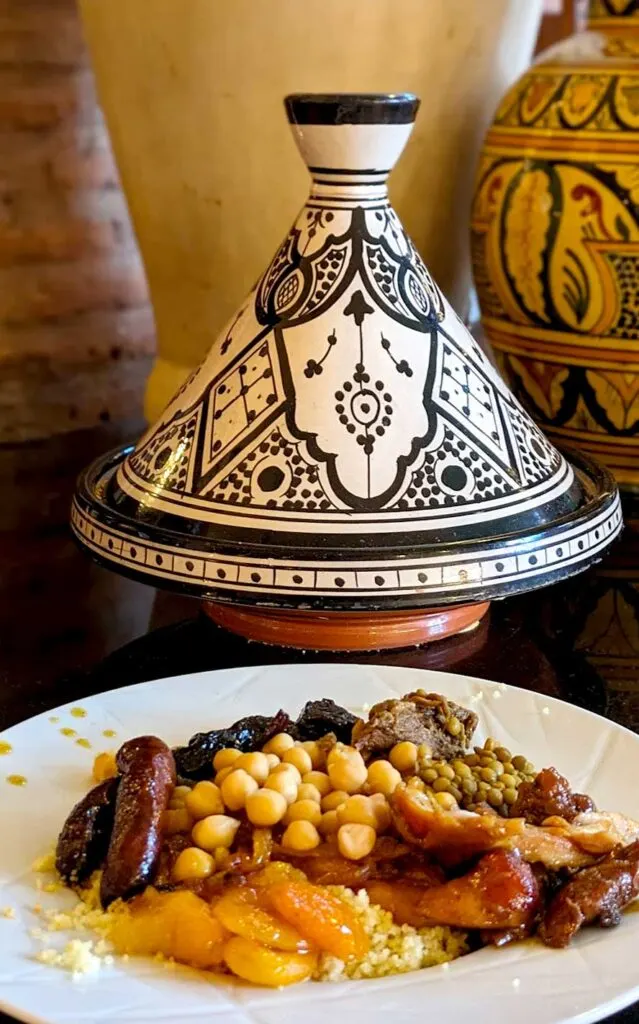
8. Fresh Local Fish (Essaouria – Coastal)
Morocco is along the coast, catering to the development of many fishing villages.
So if you’re going to the coast in Morocco (like Essaouria), you have to try try some fish.
Local fish includes sardines, mackerel, hake, whiting, sole, pandora, sea bream.
But if you’re staying in land, you can still get some Moroccan fish. We actually had a mackerel salad cooked for us by a Berber chef in the middle of the High Atlas mountains.
>> Read More: How To (& Why) Visit Berber Villages In The High Atlas Mountains From Marrakech
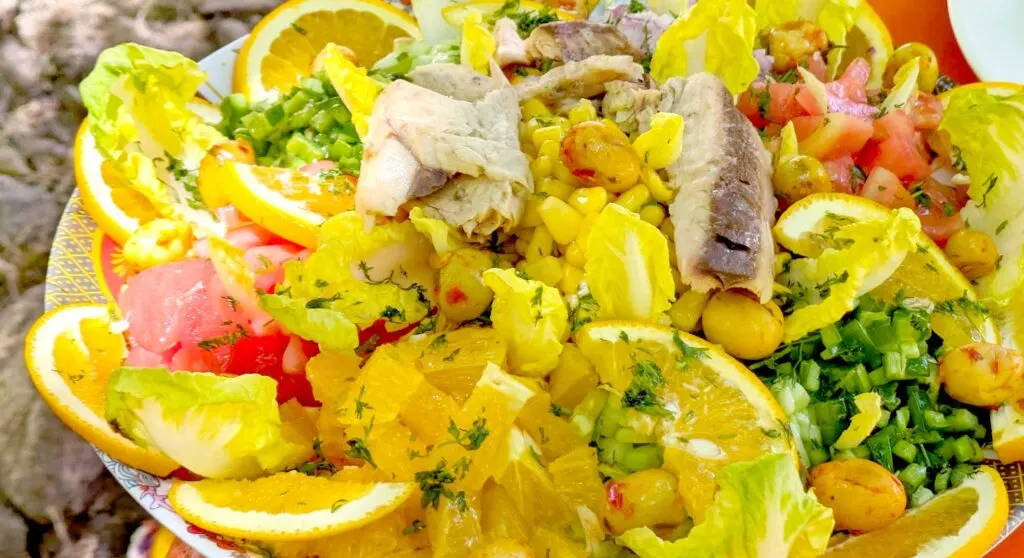
9. Pastilla / B’stilla
Pastilla was my favourite new find in Morocco, It was unlike anything I’d eaten before.
You’ve probably had sweet pies before, and you might have even tried meat pies before.
But b’stilla is a mix of savoury and sweet pie all mixed in one (and it’s absolutely DELICIOUS!).
B’stilla is a meat or seafood pie that combines classic Ras El Hanout spices with the sweetness from dates and flakey pastry dough to keep it all together.
I was surprised when I saw both cinnamon and powdered sugar sprinkled on top!
Where to try it in Marrakech? I LOVED the B’stilla at Café Guerrab near Jemaa el-Fnaa.
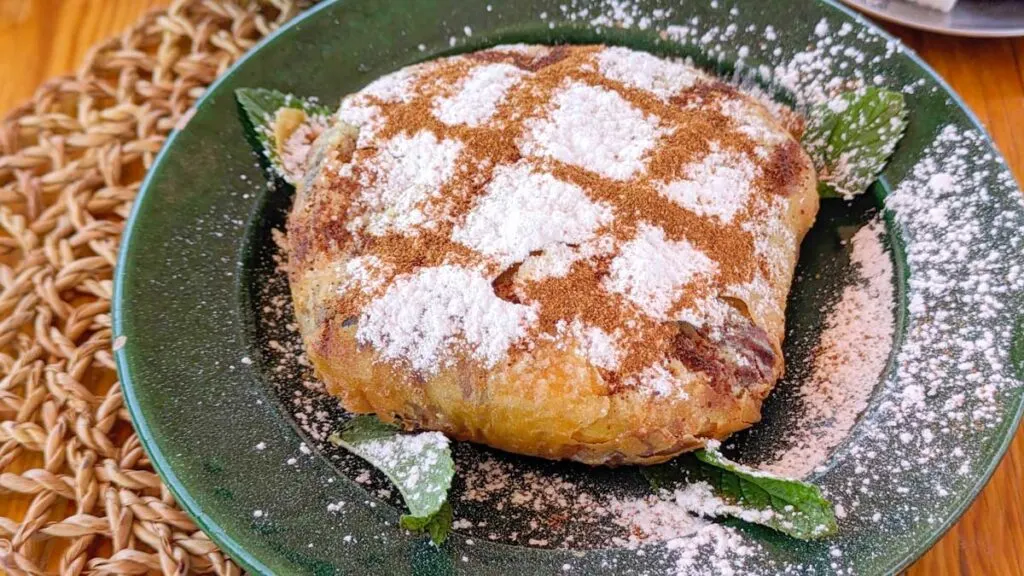
10. Briouat / Briwat
Like tajine and couscous, briouat is an umbrella term for a sweet or savoury puff pastry in Morocco.
It can be either a cylindrical or triangle shape, and can be filled with anything from meat, to seafood and fish, and even cheese!
In fact, my favourite briouat in Marrakech was cheese filled from Café Guerrab near Jemaa el-Fnaa.
P.S. Easily know what food to try while you’re in Morocco, and keep track of the dishes you’ve already tried, with my Marrakech Morocco travel planner with a complete Moroccan food checklist!
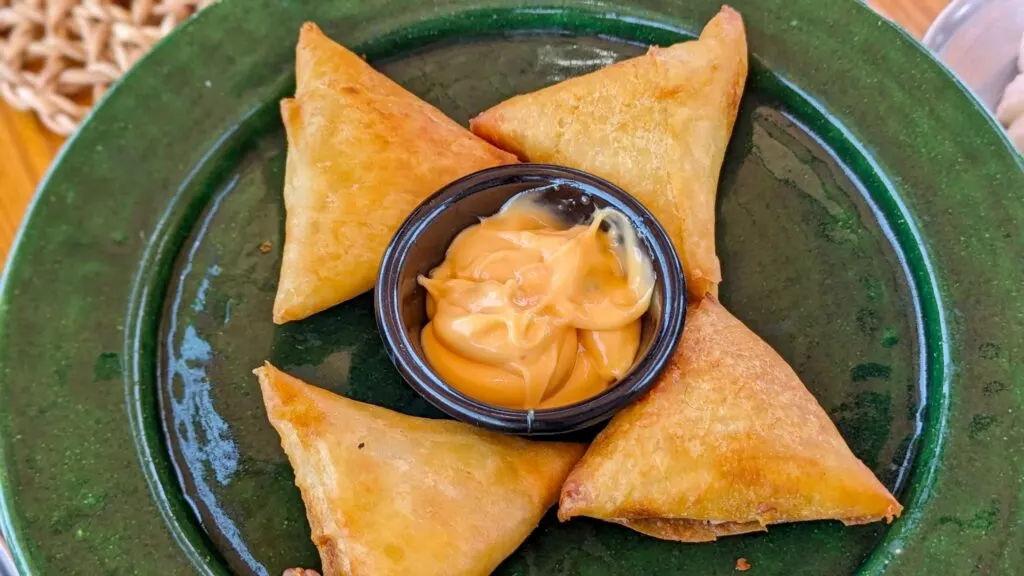
11. Zaalouk – Traditional Moroccan Food
Zaalouk is an eggplant side dish or a starter in Morocco. It’s essentially Moroccan baba ganoush.
It’s grilled and fried eggplant mixed tomatoes and spices to create an eggplant purée spread.
P.S. even if you doesn’t typically like eggplants because of their skin and texture, you should still try Zaalouk. It’s cooked down so much that you hardly notice the texture of the eggplant, and the spices take over!
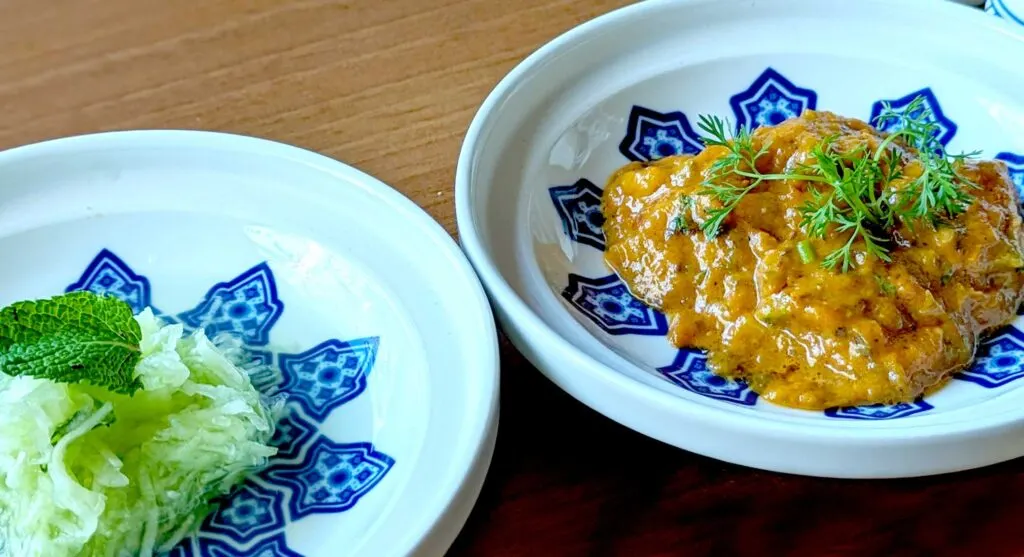
12. Khobz (Moroccan Bread)
Khobz is a traditional Moroccan style bread. And you might be wondering why I’m recommending bread as one of the best Moroccan foods to try…
Well at first you think it’s just bread, but there’s something about it that has you coming back for more.
The dough is light and soft, it’s not too sweet, and it’s addictive.
It’s often served as a side for tagine to help scoop everything up.
I had when I went on an organized hike in the High Atlas Mountains. The tour included a traditional Berber lunch in the valley. They served Khobz that was actually cooked by our guides grandmother!
But you can find this bread served as a side in Marrakech as well!

13. Semolina Pancales / Baghrir
This was my breakfast of choice every morning at the Club Med La Palmerie.
Semolina pancakes get their name from the semolina flour that’s used to make them.
You can always tell it’s a semolina pancake from its unique thousand holes on one side of the pancake. These are created by letting the pancake cook only on one side instead of flipping it halfway.
It’s also not a very sweet pancake, in fact, the flavours aren’t very strong at all. This is the vessel to pair other Moroccan spreads like amlou and honey.
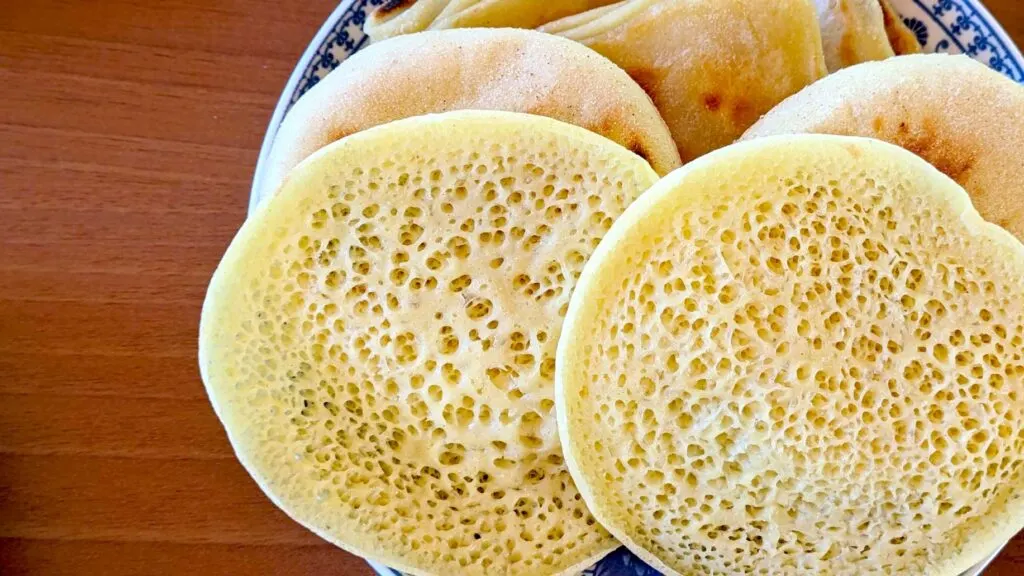
14. Msemen
Another option for traditional Moroccan food for breakfast is msemen.
Msemen is known as a Moroccan crêpe that’s ver recognizable by its square shape. To me it was less like a crepe, as it’s thin pieces of dough folded over and pan-fried offered a chewier texture.
It’s also not overly sweet either, making it the perfect pairing to Moroccan breakfast spreads as well.
Book a local street food tour of Marrakech to try traditional Moroccan food, including Msemen!

15. Dates & Walnuts (Preferably Together!)
Both dates and walnuts are native to Morocco. In fact, Medjool dates is one of the most popular varieties of dates, and they happen to be from Morocco.
But you have to try Medjool dates and Moroccan walnuts together. I never realized what a good pairing walnuts and dates were until my Berber guide offered me this mix during our hike thourgh the Atlas mountains.
The bitterness of the walnuts are offset by the sweetness of the dates.
You don’t have to go to a restaurant to try this combination, just pick up some walnuts and dates when shopping at a market in Morocco, and mix them together!
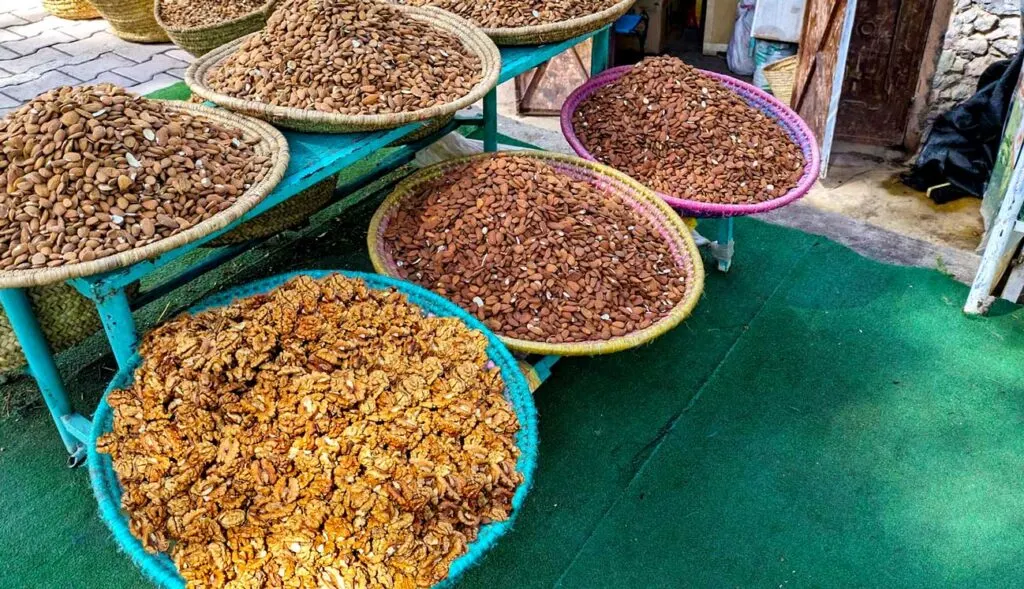
Honourable Mention: Harira
Personally, this wasn’t my favourite traditional Moroccan food, but I’m leaving it up to the fact that I only tried it from one place (which was my hotel)… so I’m giving it the benefit of the doubt!
Harira is a Moroccan soup that’s traditionally served on Ramadan to break the fast in the evenings.
You can find it at most of the touristy restaurants in the heart of Marrakech. But you might have to wait until dinner to try it because it might not be ready yet for lunch (which was our issue!).
So the one I was left trying reminded me a tad too much of Campbells tomato soup with the addition of cilantro and celery… and I don’t think this is what it’s supposed to taste like!

Bonus! The Best Desserts To Try In Morocco
Moroccan desserts get their own section because there are a lot of them. I’m barely even scratching the surface, but these were some of my favourites!
The best thing to do is to order the plate of Moroccan desserts at a restaurant when you see it. This will be a variety of the most popular desserts in Morocco.
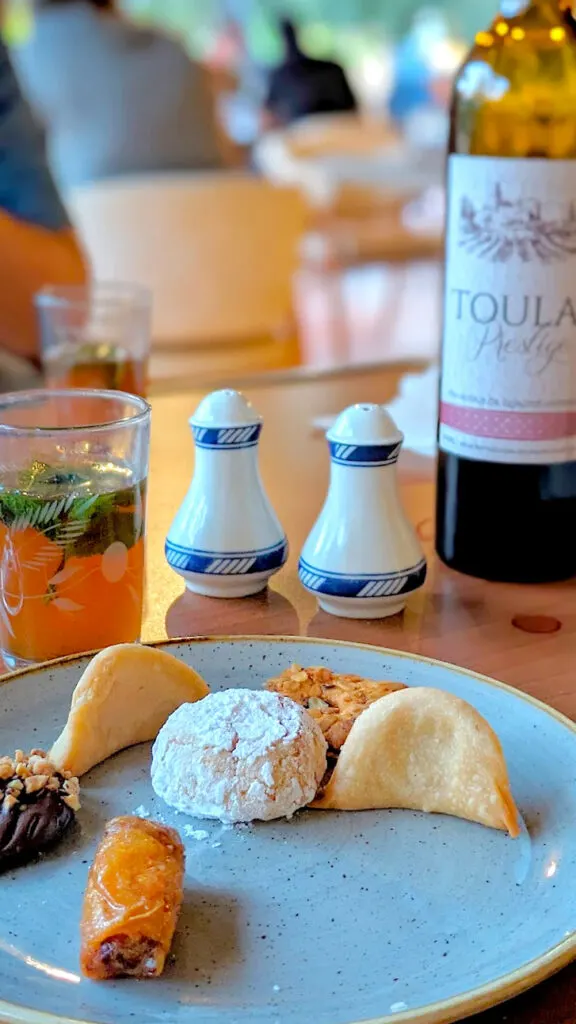
Chebakia
Chebakia was my all time favourite Moroccan dessert and I only had it once in Morocco. That’s because it’s traditionally served on Ramadan or for special celebrations (it’s actually served with harira soup!).
Strips of dough are glazed in honey and orange blossom water and shaped to look like a beautiful rose.
It’s sweet, it’s crispy, it’s somehow so juicy that it melts in your mouth!
Where to find it in Marrakech? Kafe Merstan serves Chabakia with their harira!
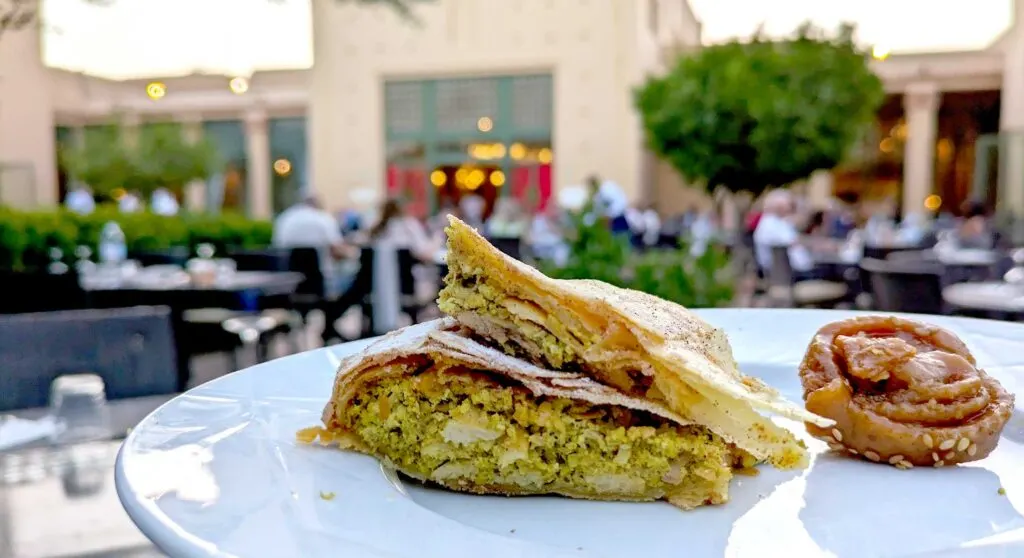
Ghriba
Ghriba is Morocco’s take on an almond cookie. It’s characterized by its’ cracked top with a light layer of powdered sugar.
And this is a Moroccan dessert so it’s not simply almond flavoured, but also aromatized with orange blossom. The ones that I tried were actually stronger in orange blossom than almond.
Kaab el Ghazal
Kaab El Ghazal, or gazelle horns, are also very easily recognizable. This was the most popular dessert we had in Morocco. It was served on every dessert platter and even with mint tea.
They’re dough filled with almond paste in the shape of a crescent moon, or gazelle horns! And as always, they’re aromatized with orange blossom.
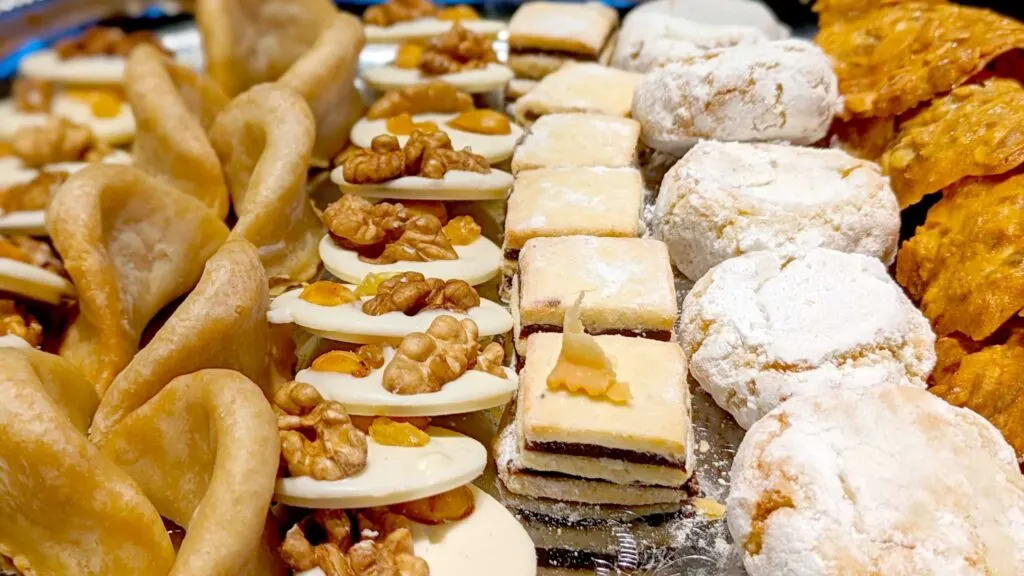
Milk Pastilla / Ktefa
You can order chicken pastilla is for dinner and milk pastilla is for dessert!
Milk Pastilla is a layered dessert of very thin crispy pastry known as warqa, fried pieces of almonds, and custard (or thickened milk).
Where to try it in Marrakech: Mabrouka Rooftop & Sky Bar offers an amazing view with most Moroccan classics, including a milk pastilla for dessert!
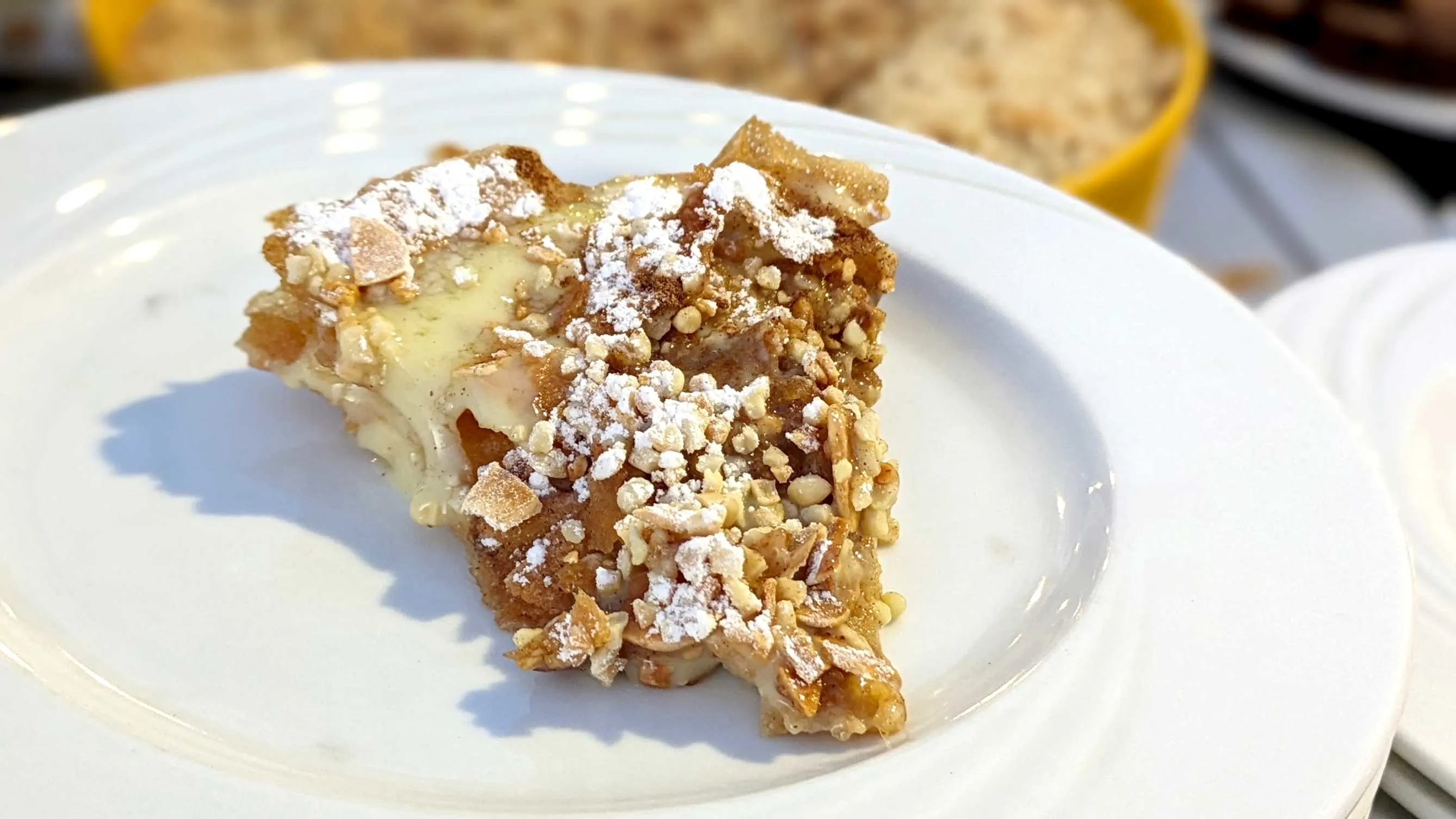
Sfenj or Chfnj
Sfenj is my Moroccan Kryptonite. It was the only thing my friends dad recommend I try in Morocco (he’s from Casablanca). It was also featured on the Marrakech episode of Somebody Feed Phil.
I looked EVERYWHERE for Sfenj, from Marrakech, to Essaouria, to the High Atlas Mountains! And I still have yet to try one!
From what I understand, it’s an unsweetened doughnut.
But according to my tour guides in Morocco, it’s really a morning specialty or a late afternoon snack. Which could have been why we couldn’t find it.

What I found odd was that there wasn’t even a hint of a sign Sfenj shop.
If somebody knows where to find them, please share in the comments below!
Apparently this Moroccan street food tour takes you to try Chfng in Marrakech, among other Moroccan delicacies!
Honourable Mention Dessert: Tiramisu à Amlou
Tiramisu à Amlou is obviously a Moroccan take on the Italian dessert. Don’t tell the Italians, but I like this version even better than the original.
Amlou was added to the bottom of their tiramisu, adding a nutty note to the dessert.
I had it at the Terrace Grill at Heure Bleue Palais hotel in Essaouria. Unfortunately, I don’t know if it’s always on the menu.

Where To Eat in Marrakech – Restaurant Suggestions
I stayed at the Club Med La Palmerie so ate most of my Moroccan meals at the hotel. They did a good job offering all the classic Moroccan dishes, including desserts. But I do recommend eating at their restaurant, El Kebir, over their buffet.
I did enjoy more traditional Moroccan food for lunch at Café Guerrab and would highly recommend it (if not for their rooftop views alone!).
We did pass by Cafés des Épices in Marrakech which had a Moroccan breakfast option and a lot of traditional Moroccan desserts to try.
Foundouk Gargaa also offers a unique terrace in the trees, a shop, and a more modern take on some of the classic Moroccan dishes.
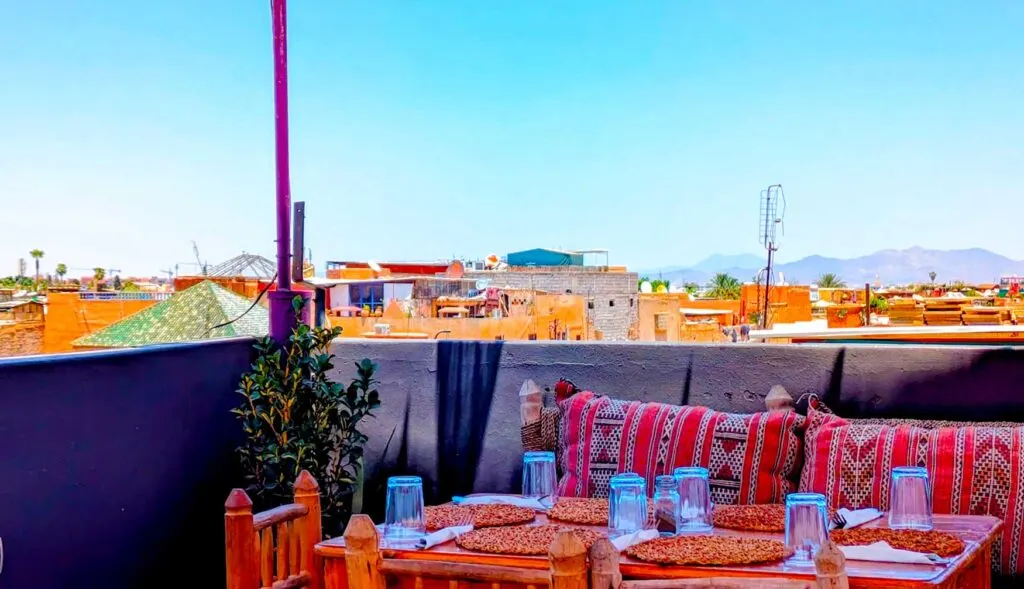
Picky Eater? Give Moroccan Foods A Chance!
I found that Morocco was one of the easiest places I’ve ever eaten as a picky eater.
I generally hate both cilantro and cinnamon (along with the similar spices like nutmeg and cardamom), which are both very popular in most classic Moroccan dishes.
But I was shocked by how much I liked everything. The way they know how to blend spices without overpowering any flavours is incredible.
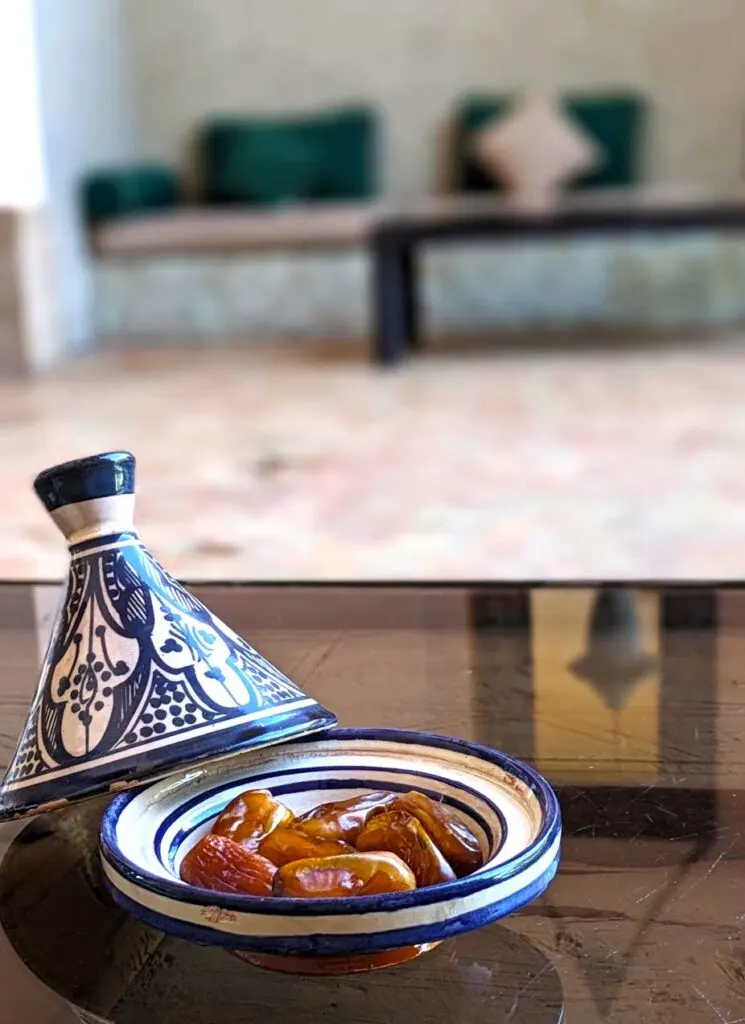
And as it turns out, they’re actually using a different variety of cinnamon than we are used to in North America (which I might like it better).
It’s also very easy to eat as a vegetarian in Morocco. Although they do have a lot of meat dishes, they also cook with a lot of lentils, chickpeas and vegetables.
With that in mind, it was also very easy to actually get a balanced meal on vacation for once.
Book a Traditional Moroccan Food Tour in Marrakech
If you’re interested in learning more about the secrets behind Moroccan cuisine, book a tour with a local guide.
You can either book a cooking class (what I did), or a food tour through Marrakech.
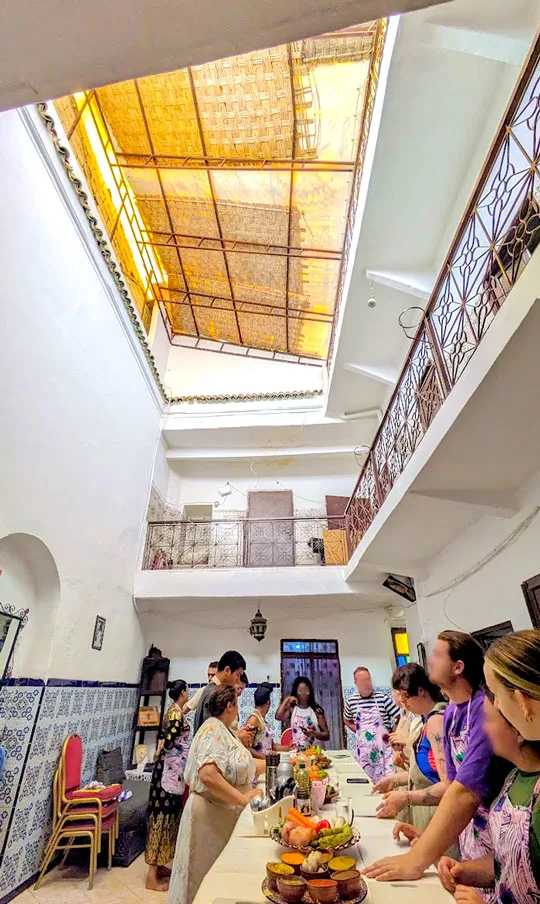
In Marrakech, this is the most popular cooking class, where you pick up ingredients at the market and then learn how to cook with them.
If cooking isn’t your style, you can also book this walking food tour through Marrakech, taking you to local spots for popular Moroccan foods.
Plan Your Perfect Trip To Morocco
Here’s some information to help plan your trip to Morocco!
P.S. Make planning a trip to Morocco even easier with my printable Marrakech travel planner on Etsy!
My Amazon Morocco Travel Essentials
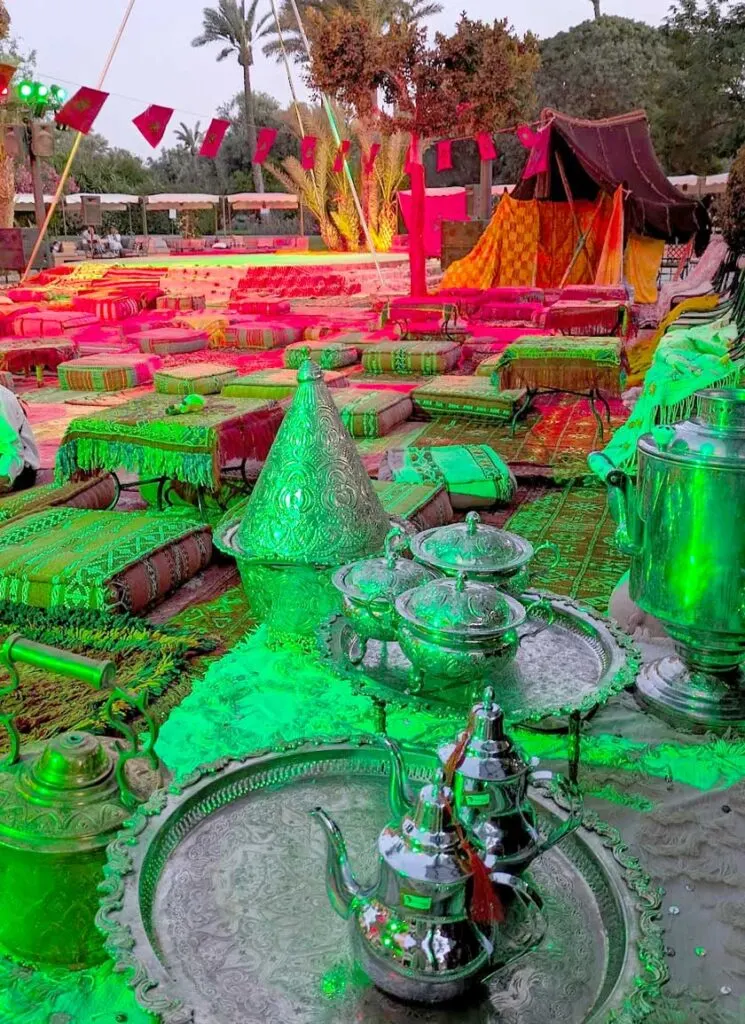
Book A Place To Stay In Marrakech
I stayed at the Club Med Marrakech La Palmeraie, and it was exactly what I was looking for – a mix of touring and relaxing without any of the stress that typical comes with travel.
But a more typical place to stay in Marrakech is in a Riad, a hotel with an open air courtyard in the middle. Sometimes there’s a pool, while other times it’s a lounge area.
Riad NayaNour has a few features that I appreciate compared to other Riads in Marrakech. For starters, the room and the courtyard pool are larger than most Riads I’ve looked at. Plus there’s also a rooftop for you to relax in the sun! If you’re a Booking.com Genius Level 2 member, you’ll also get breakfast included with your stay! See room rates and availability!
Riad Lyla is another good option in Marrakech, and it’s even more budget friendly! It offers a wonderful pool and rooftop for guests to enjoy and your booking even has a delicious breakfast included! See room rates and availability.
Or see more Riad and accommodation options on Booking.com.

Simple Marrakech Travel Guide
Check out my digital and printable travel guide for first timers to Marrakech Morocco.
Use it digitally on your phone to check off top attractions as you do them. Or print it out in one of three size formates, 8.5 x 11, 5.5 x 8.5, or 2.75 x 4.25 for a packable mini travel planner!
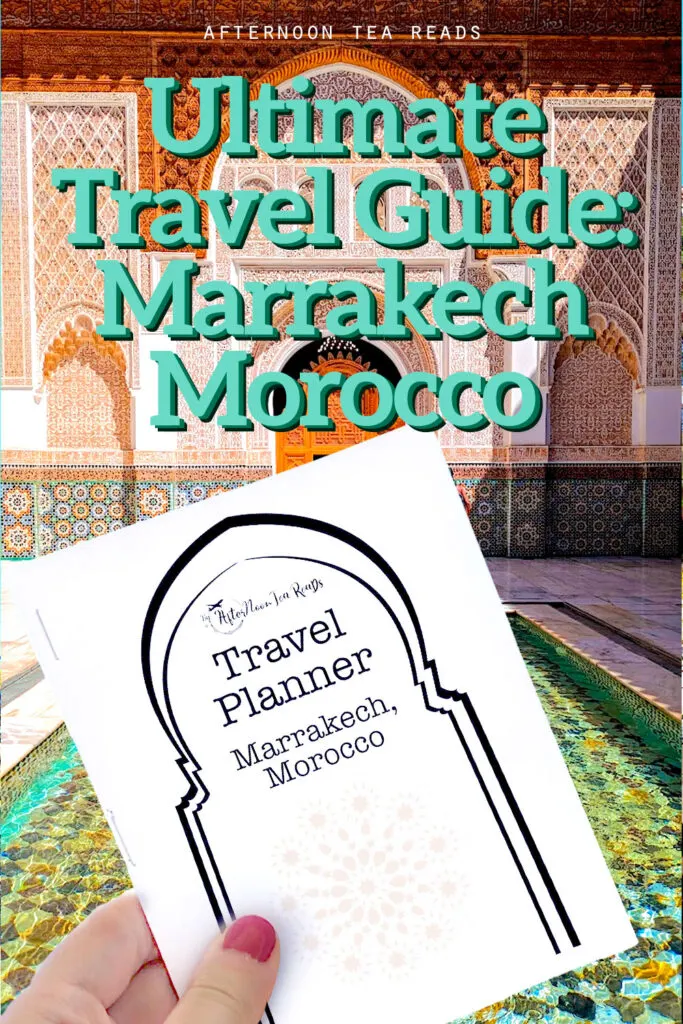
8 Pages included:
- Cover Page
- Morocco at a Glance: with tips and quick information about Morocco
- Marrakech at a Glance: with tips and advice for traveling to Marrakech
- Marrakech Top Things To Do Checklist: don’t miss a top thing to do in Marrakech by checking off activities as you do them!
- Moroccan food to try checklist
- Moroccan souvenirs to buy in Marrakech
- Common Moroccan phrases in Arabic and French
- Packing list for Morocco
Read More Related Posts
- Is Marrakech Morocco Safe According To A Wary Traveler?
- What To Wear In Morocco? A Simple Packing Guide For Women
- 20 Moroccan Souvenirs To Look For In The Markets
Click Image To Share Or Save This Post
Last update on 2025-05-28 / Affiliate links / Images from Amazon Product Advertising API






